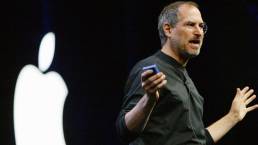Unraveling the secrets behind
Apple's compelling brand story
The Power of Apple’s Strategic Narrative
In the fast-paced world of technology, few companies have managed to captivate audiences and dominate markets quite like Apple. But what’s the secret behind their enduring success? The answer lies in their masterfully crafted strategic narrative – a story that goes beyond products and features to create a lasting emotional connection with consumers. As Andy Raskin, a renowned strategic narrative expert, puts it, “It’s less about “you have a big problem” and more about “come join this new world.” Apple has perfected this approach, positioning itself not just as a tech company, but as a catalyst for change and innovation in people’s lives.
The Evolution of Apple’s Narrative
Apple’s story began in a garage in 1976, with Steve Jobs and Steve Wozniak’s vision of making computers accessible to everyone. Since then, the narrative has evolved, but its core elements have remained consistent: innovation, simplicity, and enhancing people’s lives through technology. In the early days, Apple’s narrative focused on democratizing technology. The famous “1984” Super Bowl commercial, directed by Ridley Scott, portrayed Apple as the rebel fighting against conformity (represented by IBM). This set the stage for Apple’s long-standing image as the innovative underdog. As Apple grew, its narrative shifted. The “Think Different” campaign in the late 1990s celebrated creativity and “the crazy ones” who change the world. This narrative positioned Apple products as tools for creative expression and innovation.
Storytelling That Resonates
One of Apple’s greatest strengths is its ability to tell compelling stories that resonate with its audience. Instead of focusing solely on product specifications, Apple’s marketing often emphasizes how its products fit into and improve people’s lives. For example, when introducing the iPod, Steve Jobs didn’t just talk about gigabytes and battery life. He said, “1,000 songs in your pocket“. This simple phrase told a story of freedom, convenience, and the joy of music – all in six words. Similarly, the “Shot on iPhone” campaign doesn’t just showcase the phone’s camera capabilities. It tells stories of creativity, personal expression, and the beauty of everyday moments captured by ordinary people.
Innovation as a Cornerstone
Apple’s narrative is inextricably linked with innovation. The company has consistently positioned itself as a pioneer, pushing the boundaries of what’s possible in technology and design.
Redefining Product Categories
Apple has a history of entering existing markets and completely redefining them. The iPod wasn’t the first MP3 player, the iPhone wasn’t the first smartphone, and the iPad wasn’t the first tablet. But in each case, Apple’s approach to these products changed the entire category. As Steve Jobs famously said, “Innovation distinguishes between a leader and a follower”. This philosophy is deeply embedded in Apple’s narrative. Each product launch is presented not just as a new item, but as a revolutionary step forward.
Design as Innovation
Apple’s commitment to design is another key element of its innovation narrative. The company has always emphasized the importance of not just how a product works, but how it looks and feels. Jony Ive, Apple’s former Chief Design Officer, once stated, “Our goals are very simple — to design and make better products. If we can’t make something that is better, we won’t do it”. This dedication to design excellence is a crucial part of Apple’s narrative of innovation.
The Ecosystem Approach
Perhaps one of the most powerful aspects of Apple’s strategic narrative is its emphasis on creating a seamless ecosystem. This narrative goes beyond individual products to tell a story of integration, simplicity, and enhanced user experience.
“It Just Works”
Apple’s ecosystem narrative is encapsulated in the phrase “It just works,” often used by Steve Jobs. This simple statement tells a powerful story of effortless technology, where devices and services work together seamlessly without user intervention. The ecosystem narrative is particularly evident in how Apple presents its services like iCloud, Apple Music, and the App Store. These aren’t just add-ons, but integral parts of the Apple experience, designed to work in harmony with the hardware.
Loyalty Through Integration
By emphasizing the benefits of its integrated ecosystem, Apple creates a narrative that encourages customer loyalty. The story isn’t just about buying a phone or a computer, but about entering a world where all your devices and services work together effortlessly. This narrative has been incredibly effective. According to a 2017 survey, 92% of iPhone users were likely to upgrade to another iPhone, demonstrating the power of the ecosystem story.

Steve Jobs presenting during an Apple event.
Source: Getty Images
Comparing Apple’s Narrative to Other Tech Giants
To truly appreciate the uniqueness of Apple’s strategic narrative, it’s helpful to compare it with other tech industry leaders. While companies like Google, Amazon, and Microsoft all have compelling narratives, Apple’s stands out in several ways.
Google: Information Accessibility
Google’s narrative centers around organizing the world’s information and making it universally accessible and useful. While powerful, this narrative lacks the emotional resonance of Apple’s story. Google tells us about what it does; Apple tells us how it will change our lives. As Sundar Pichai, CEO of Google, stated, “Our mission is to organize the world’s information and make it universally accessible and useful”. This mission is clear and impactful, but it doesn’t create the same personal connection that Apple’s narrative does.
Amazon: Customer Obsession
Amazon’s narrative focuses on customer obsession and innovation. Jeff Bezos famously said, “We see our customers as invited guests to a party, and we are the hosts. It’s our job every day to make every important aspect of the customer experience a little bit better”. While this customer-centric approach is powerful, it lacks the aspirational quality of Apple’s narrative. Amazon tells a story of convenience and service; Apple tells a story of creativity and personal empowerment.
Microsoft: Empowering Every Person and Organization
Microsoft’s narrative under Satya Nadella has shifted to “empowering every person and every organization on the planet to achieve more”. This is a compelling story, but it’s broader and less focused than Apple’s narrative. Microsoft’s story is about potential; Apple’s is about realization. Apple doesn’t just tell you that you can achieve more; it shows you how its products will help you do it.
Key Strategic Issues for Apple
While Apple’s strategic narrative has been incredibly successful, the company faces several key issues in maintaining and evolving this narrative.
Balancing Innovation and Familiarity
Apple must continue to innovate to maintain its image as a trendsetter. However, it also needs to maintain the familiarity and ease-of-use that its customers value. This balance is crucial to Apple’s narrative of “It just works”.
Adapting to Changing Consumer Priorities
As consumer priorities shift towards issues like privacy, sustainability, and ethical technology, Apple needs to adapt its narrative. The company has already begun this process, emphasizing privacy features and environmental initiatives in recent years.
Maintaining Ecosystem Advantage
As competitors develop their own integrated ecosystems, Apple needs to continue emphasizing the unique benefits of its ecosystem. This includes not just integration, but also quality, security, and user experience.
The Narrative of Apple: A Closer Look
Apple’s narrative is multifaceted, but at its core, it’s a story of empowerment through technology. Let’s break down the key elements:
1. Simplicity and Elegance
Apple tells a story of technology that’s not just powerful, but also beautiful and easy to use. This narrative is evident in everything from product design to packaging to user interfaces.
2. Innovation and Creativity
Apple positions itself as a company that doesn’t just follow trends, but creates them. Its narrative encourages customers to see themselves as innovators and creatives.
3. Quality and Premium Experience
Apple’s narrative justifies its premium pricing by emphasizing quality, durability, and a superior user experience. This story turns Apple products from mere purchases into investments.
4. Ecosystem and Integration
Apple tells a story of a seamless technological world, where all your devices and services work together effortlessly.
5. Privacy and Security
In recent years, Apple has increasingly emphasized privacy and security in its narrative, positioning itself as a protector of user data in a world of increasing digital threats.
Examples of Apple’s Strategic Narrative in Action
To truly understand Apple’s strategic narrative, let’s look at some specific examples:
The iPhone Launch (2007)
When Steve Jobs introduced the iPhone, he didn’t just present it as a new product. He framed it as a revolutionary device that would change the way we communicate, work, and live. This narrative positioned the iPhone not just as a phone, but as a lifestyle-changing tool.
The “Get a Mac” Campaign (2006-2009)
This campaign personified Macs and PCs, creating a narrative that Macs were cool, creative, and easy to use, while PCs were stodgy and problematic. It’s a perfect example of how Apple uses storytelling to create emotional connections with its audience.
The Apple Watch Introduction (2014)
When introducing the Apple Watch, Tim Cook emphasized health and fitness features, positioning the device as a tool for improving users’ lives. This narrative went beyond tech specifications to tell a story of personal well-being and connection.
Actionable Advice: Crafting Your Own Strategic Narrative
While few companies can match Apple’s resources, there are lessons any business can apply:
- Focus on benefits, not features: Tell stories about how your product or service improves people’s lives.
- Create an emotional connection: Use storytelling to make your audience feel something.
- Be consistent: Ensure your narrative is reflected in every aspect of your business, from product design to customer service.
- Evolve thoughtfully: Update your narrative to reflect changing times, but maintain your core values.
- Emphasize quality and user experience: Position your offerings as investments, not just purchases.
Conclusion: The Power of a Compelling Narrative
Apple’s strategic narrative has been a key factor in its rise to become one of the world’s most valuable companies. By telling a consistent, emotionally resonant story of innovation, simplicity, and ecosystem integration, Apple has created a brand that inspires fierce loyalty and continues to shape the tech industry. Apple has created a narrative that doesn’t just sell products, but invites customers to be part of a movement towards a more innovative, creative, and connected world.
By studying and adapting elements of Apple’s strategic narrative, businesses of all sizes can create more compelling brand stories, forge stronger connections with their customers, and drive long-term success.
Contact me if you have any questions you’d like answered!
And if you enjoyed this article, don’t miss my analysis of Lego’s Strategic Narrative and Nike’s Strategic Narrative. Both companies have crafted compelling stories that resonate deeply with their audiences, showcasing how effective storytelling can elevate brands in competitive markets.
Related Posts
January 16, 2025
Unraveling Allbirds’ Strategic Narrative
Discover how Allbirds' strategic narrative drives success through…
November 18, 2024
Crafting the Future: OpenAI’s Strategic Narrative
Explore OpenAI's strategic narrative and discover how storytelling shapes its…
November 18, 2024
Unpacking Shopify’s Strategic Narrative: Rewriting the Rules of eCommerce
Explore how Shopify transformed from a snowboard shop to a global commerce…
November 12, 2024
Canva’s Strategic Narrative: How Design Democratization Created a $40 Billion Empire
Discover how Canva's strategic narrative empowers creativity through…
Related Posts
January 16, 2025
Unraveling Allbirds’ Strategic Narrative
Discover how Allbirds' strategic narrative drives success through…
November 18, 2024
Crafting the Future: OpenAI’s Strategic Narrative
Explore OpenAI's strategic narrative and discover how storytelling shapes its…
November 18, 2024
Unpacking Shopify’s Strategic Narrative: Rewriting the Rules of eCommerce
Explore how Shopify transformed from a snowboard shop to a global commerce…
November 12, 2024
Canva’s Strategic Narrative: How Design Democratization Created a $40 Billion Empire
Discover how Canva's strategic narrative empowers creativity through…







